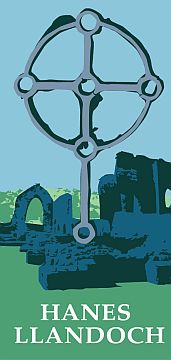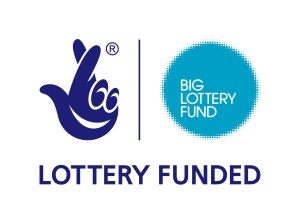The Abbey at St Dogmaels
Entry to this beautiful Abbey is free and well behaved dogs on leads are welcome. The Coach House Museum is also free to visit and houses many relics and artefacts from the Abbey grounds. The museum display ldisplays a chronological history of the Abbey's fascinating and turbulent past
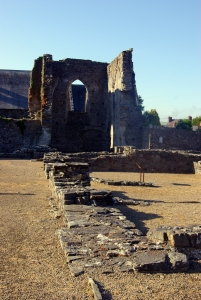
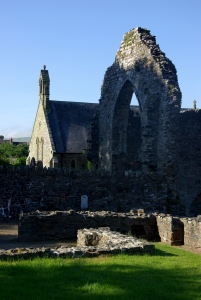
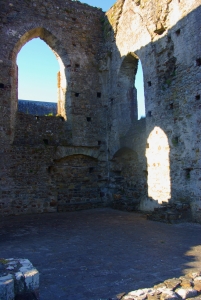
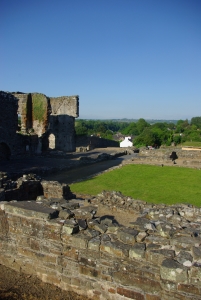
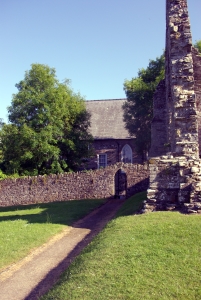

The Monks of Tiron
By the later part of the eleventh century, a growing dissatisfaction was being felt in France with the regime of existing monasteries in that country. As a result of slackness and negligence and a too comfortable way of living, the Benedictine and Cluniac monasteries had lost much of the essential spirit of the Rule of their sixth-century founding father, St Benedict.
In a search for a life of greater austerity and simplicity many monks left the greater abbeys, seeking out instead wild and deserted places, and living the lives of hermits. One such group of hermits went to live in the forest of Craon near the eastern borders of Brittany. Amongst them was Bernard (d. 1117), a monk who had previously been at the abbey of St Cyprian, near Poitiers.
After being sought out by the monks of his old abbey, Bernard retired to an even more remote and deserted hermitage at Chaussey on the Normandy coast. Later he returned to St Cyprian to become its abbot, but the life did not suit him and before long he left the monastery again to return to his hermitage. At his hermitage Bernard gathered around him a group of followers. Together with his disciples, in 1109 he established a new monastery at Nogent, in the diocese of Chartres. There, the monks attempted to return to a strict interpretation of the Rule of St Benedict in the ordering of their daily lives. Five years later the abbey moved to Tiron.
Bernard was, according to his biographer (himself a monk of Tiron), not only a generous and humble man who had undergone many hardships, but also an influential preacher. Bernard's reputation for holiness attracted attention and brought the new monastery to the notice of those in power. Soon, groups were sent out from Tiron to establish new colonies, each one comprising twelve monks headed by a prior. Regular assemblies, attended by representatives of each daughter foundation, were held at Tiron so that the purity of the new order's discipline could be maintained. St Bernard of Abbeville, as he later became known, died in 1117 at the age of seventy-one.
Tiron's influence in Britain was limited. St Dogmaels was the only Tironian abbey to he established in Wales or England, although the house also had daughter priories in Wales and Ireland. A few Tironian abbeys were established in Scotland, but they soon formed their own independent order.
Everyday life
A key feature of the Tironian congregation was an insistence that the monks themselves should be skilled craftsmen such as carvers, joiners, smiths, and painters. Nevertheless, much of their time was taken up with prayer and their days were organised around a series of services in the abbey church. Ami, as with monks in other monasteries, they were expected to keep the rule of silence. At first the Tironian monk's habit was light grey in colour; later it was changed to black.
Although initially the monks came from France, novices were, no doubt, soon recruited locally. Indeed, St Dogmaels may have been one of the first Norman abbeys to recruit Welshmen who in an earlier age might have found a calling in one of the clas churches.
The monastic vows laid great stress on poverty, chastity and obedience, and these ideals were characteristic of the monastic life, especially in the early years. To these three virtues might be added that of charity, for the abbey would have taken in any pilgrims and travellers requiring hospitality and perhaps occasionally the poor and the sick as well. Later, an abbey might become a place of retirement for previous incumbents and those who could afford to purchase annuities.
As well as prayer and manual work, study was also an important part of a monk's life. St. Dogmaels had its own library. One of its books, a thirteenth-century copy of Eusebiuss's Historia Ecclesiastica, has survived and is now in the library of St John's College, Cambridge. In an age when few could read or write outside the church, a community such as a monastery often became important as a cultural centre. This seems to have been the case with St Dogmaels. Long after it had ceased to he a monastery, it was remembered nostalgically by the poet Sion Mawddwy as the place where the silver harp of Henllys had traditionally been delivered for safe keeping.
Not all aspects of the monastic life at St Dogmaels were to continue to flourish, however, and in later centuries the abbey suffered from a decline in standards as well as in its financial position. In 1402, for instance, at the time of the visitation by the bishop of St David’s, there appears to have been considerable deterioration. Due to pestilence and neglect, the number of monks had been reduced to four, but they were consuming food for a much larger number. One of the monks, a certain Howel Lange, had been found drunk and was ordered to desist from drinking wine and meddyglyn (the Welsh form of mead) for a year 'on account of his excess and his evil deeds'. Evidently, the monks had also been drinking in taverns in St Dogmaels and Cardigan. Moreover, they had been consorting with women, while ordinary people had been allowed to wander in and out of the cloister. The bishop commanded that all these practices be stopped and that none of the monks and lay brothers be allowed outside the monastery without special permission.
(CADW 1992)
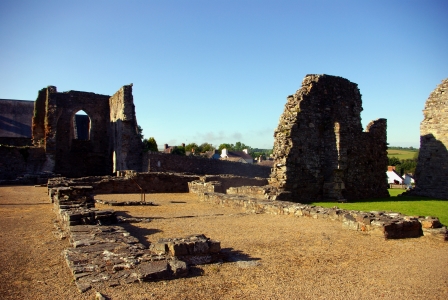
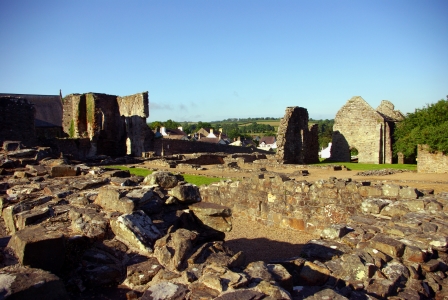
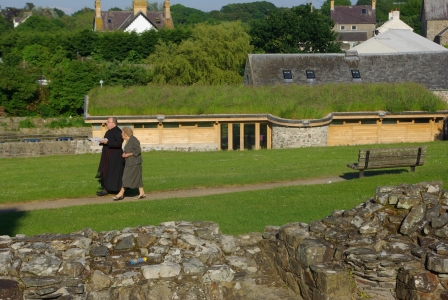
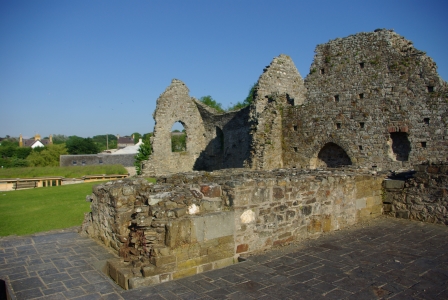
The dissolution and later history of the abbey
Despite the undoubted improvement, the monastic, life at St. Dogmaels remained a pale reflection of that to which the early monks had aspired. The end came in 1536 when, along with hundreds of other houses throughout England and Wales with an annual income of less than £200, the abbey was suppressed by King Henry VIII. The abbot and his eight monks had already acknowledged the king's supremacy in 1534 and no attempt was made to stem the tide of change. The assessed annual value of the monastery at the dissolution was £87 8s.6d., and its rentals and tithes were assessed in 1537 to be £140 8s. 8.5d.
The major part of the abbey's possessions, including Caldey and Fishguard were leased to John Bradshaw of Presteigne, in Radnorshire. A few years later, in 1543, Bradshaw was able to purchase the properties which he already had on lease. He built a mansion for himself, probably within the abbey precinct, and no doubt used stone from the abbey buildings for its construction. Subsequently, Bradshaw's mansion was allowed to fall into decay and today no remains of it are visible unless the later alterations and additions at the end of the west range belong to that building. Bradshaw was excused from keeping the chancel in repair, possibly because it had already been stripped of its lead. At the beginning of the seventeenth century George Owen described it as a ruin. In 1646 the site was bought by David Parry of Neuadd-Trefawr, near Cardigan, but neither he nor his descendants appear to have lived there.
The blocking of the nave at its western end to form a vestibule suggests that this part of the abbey church was later altered for parochial use. If so, it must have replaced the existing parish church of St Thomas the Apostle which stood on the opposite side of the stream, at the corner of Shingrug and David Street. According to witnesses in a dispute, the old parish church was still in use during the first half of the seventeenth century. It is unlikely, therefore, that the alterations to the monastic nave could have been made earlier than about 1640. The north transept is divided from the rest of the abbey church by the base of a late wall, suggesting that it was walled off for use as a private chapel, perhaps for the same family that might have earlier paid for its elaborate rebuilding in the sixteenth century.
Early in the eighteenth century, a new parish church was erected alongside the old abbey church. A century later, in 1847, this was replaced by the church which now stands on the site. Initially, in 1866, the vicarage and its coach house, were built with materials from the old abbey buildings.
In 1934 the remains of the abbey were placed in State guardianship by the Representative Body of the Church in Wales. The site was cleared and the masonry consolidated between 1947 and 1968 and the ruins are now maintained by Cadw: Welsh Historic Monuments.
(CADW 1992)
For more information on the history of St. Dogmaels the Abbey and the surrounding area, visit the website of local historian Glen Johnson http://www.glen-johnson.co.uk/


